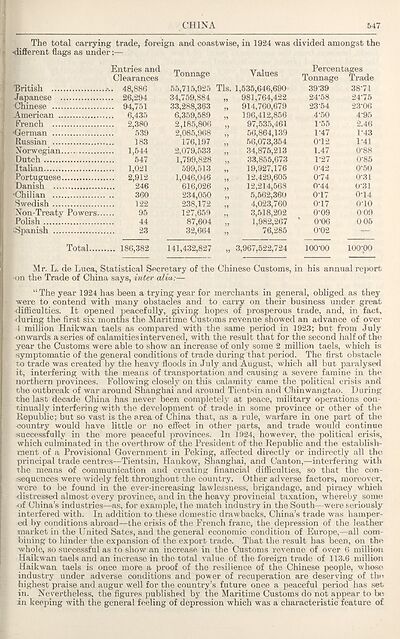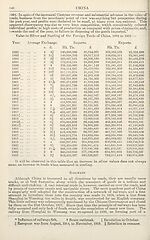1926
(603) Page 547
Download files
Complete book:
Individual page:
Thumbnail gallery: Grid view | List view

CHINA
547
The total carrying trade, foreign and coastwise, in 1924 was divided amongst the
I -different flags as under:—
Entries and
Clearances
'British 48,886
Japanese 26,294
Chinese 94,751
American 6,435
French 2,380
•German 539
Russian 183
Norwegian 1,544
Dutch 547
Italian 1,021
Portuguese 2,912
Danish
Ghilian
Swedish
Non-Treaty Powers..
Polish
•Spanish
246
360
Tonnage
55,715,925 Tls.
34,759,884
33,288,363
6,359,589
2,185,806
2,085,968
176,197
2,079,533
1,799,828
599,513
1,046,046
616,026
234,050
238,172
127,659
87,604
32,664
Values
1,535,646,690
981,764,422
914,760,679
196,412,856
97,535,461
56,864,139
56,073,354
34,875,213
33,855,673
19,927,176
12,429,605
12,214,568
5,562,360
4,023,760
3,518,202
1,982,267
76,285
Percentages
Tonnage Trade
24-58
23-54
0-12
1.47
1-27
0-42
0-74
0-44
0-09
0-06
0-02
38-71
24-75
23-06
4-95
2.46
1-43
1-41
0-88
0-85
0-50
0-31
0-31
0-14
o-io
009
0 05
Total 186,31
141,432,827 „ 3,967,522,724 lOO'OO
Mr. L. de Luca, Statistical Secretary of the Chinese Customs, in his annual report
on the Trade of China says, inter alia:—
“ The year 1924 has been a trying year for merchants in general, obliged as they
were to contend with many obstacles and to carry on their business under great
§ difficulties. It opened peacefully, giving hopes of prosperous trade, and, in fact,
during the first six months the Maritime Customs revenue showed an advance of over
f 4 million Haikwan taels as compared with the same period in 1923; but from July
I onwards a series of calamities intervened, with the result that for the second half of the
I _year the Customs were able to show an increase of only some 2 million taels, which is
1 symptomatic of the general conditions of trade during that period. The first obstacle
r. to trade was created by the heavy floods in July and August, which all but paralysed
it, interfering with the means of transportation and causing a severe famine in the
| northern provinces. Following closely on this calamity came the political crisis and
I' the outbreak of war around Shanghai and around Tientsin and Chinwangtao. During
|\ the last decade China has never been completely at peace, military operations con-
17 tinually interfering with the development of trade in some province or other of the
jf Republic; but so vast is the area of China that, as a rule, warfare in one part of the
I -country would have little or no effect in other parts, and trade would continue
| successfully in the more peaceful provinces. In 1924, however, the political crisis,
: which culminated in the overthrow of the President of the Republic and the establish-
| merit of a Provisional Government in Peking, affected directly or indirectly all the
principal trade centres—Tientsin, Hankow, Shanghai, and Canton,—interfering with
| the means of communication and creating financial difficulties, so that the con¬
sequences were widely felt throughout the country. Other adverse factors, moreover,
* were to be found in the ever-increasing lawlessness, brigandage, and piracy which
- -distressed almost every province, and in the heavy provincial taxation, whereby some
| of China’s industries—as, for example, the match industry in the South—were seriously
| interfered with. In addition to these domestic drawbacks, China’s trade was hamper-
f< ed by conditions abroad—the crisis of the French franc, the depression of the leather
market in the United Sates, and the general economic condition of Europe,—all com-
! billing to hinder the expansion of the export trade. That the result has been, on the
’ whole, so successful as to show an increase in the Customs revenue of over 6 million
Haikwan taels and an increase in the total value of the foreign trade of 113.6 million
7 Haikwan taels is once more a proof of the resilience of the Chinese people, whose
industry under adverse conditions and power of recuperation are deserving of the
highest praise and augur well for the country’s future once a peaceful period has set
r in. Nevertheless, the figures published by the Maritime Customs do not appear to be
in keeping with the general feeling of depression which was a characteristic feature of
547
The total carrying trade, foreign and coastwise, in 1924 was divided amongst the
I -different flags as under:—
Entries and
Clearances
'British 48,886
Japanese 26,294
Chinese 94,751
American 6,435
French 2,380
•German 539
Russian 183
Norwegian 1,544
Dutch 547
Italian 1,021
Portuguese 2,912
Danish
Ghilian
Swedish
Non-Treaty Powers..
Polish
•Spanish
246
360
Tonnage
55,715,925 Tls.
34,759,884
33,288,363
6,359,589
2,185,806
2,085,968
176,197
2,079,533
1,799,828
599,513
1,046,046
616,026
234,050
238,172
127,659
87,604
32,664
Values
1,535,646,690
981,764,422
914,760,679
196,412,856
97,535,461
56,864,139
56,073,354
34,875,213
33,855,673
19,927,176
12,429,605
12,214,568
5,562,360
4,023,760
3,518,202
1,982,267
76,285
Percentages
Tonnage Trade
24-58
23-54
0-12
1.47
1-27
0-42
0-74
0-44
0-09
0-06
0-02
38-71
24-75
23-06
4-95
2.46
1-43
1-41
0-88
0-85
0-50
0-31
0-31
0-14
o-io
009
0 05
Total 186,31
141,432,827 „ 3,967,522,724 lOO'OO
Mr. L. de Luca, Statistical Secretary of the Chinese Customs, in his annual report
on the Trade of China says, inter alia:—
“ The year 1924 has been a trying year for merchants in general, obliged as they
were to contend with many obstacles and to carry on their business under great
§ difficulties. It opened peacefully, giving hopes of prosperous trade, and, in fact,
during the first six months the Maritime Customs revenue showed an advance of over
f 4 million Haikwan taels as compared with the same period in 1923; but from July
I onwards a series of calamities intervened, with the result that for the second half of the
I _year the Customs were able to show an increase of only some 2 million taels, which is
1 symptomatic of the general conditions of trade during that period. The first obstacle
r. to trade was created by the heavy floods in July and August, which all but paralysed
it, interfering with the means of transportation and causing a severe famine in the
| northern provinces. Following closely on this calamity came the political crisis and
I' the outbreak of war around Shanghai and around Tientsin and Chinwangtao. During
|\ the last decade China has never been completely at peace, military operations con-
17 tinually interfering with the development of trade in some province or other of the
jf Republic; but so vast is the area of China that, as a rule, warfare in one part of the
I -country would have little or no effect in other parts, and trade would continue
| successfully in the more peaceful provinces. In 1924, however, the political crisis,
: which culminated in the overthrow of the President of the Republic and the establish-
| merit of a Provisional Government in Peking, affected directly or indirectly all the
principal trade centres—Tientsin, Hankow, Shanghai, and Canton,—interfering with
| the means of communication and creating financial difficulties, so that the con¬
sequences were widely felt throughout the country. Other adverse factors, moreover,
* were to be found in the ever-increasing lawlessness, brigandage, and piracy which
- -distressed almost every province, and in the heavy provincial taxation, whereby some
| of China’s industries—as, for example, the match industry in the South—were seriously
| interfered with. In addition to these domestic drawbacks, China’s trade was hamper-
f< ed by conditions abroad—the crisis of the French franc, the depression of the leather
market in the United Sates, and the general economic condition of Europe,—all com-
! billing to hinder the expansion of the export trade. That the result has been, on the
’ whole, so successful as to show an increase in the Customs revenue of over 6 million
Haikwan taels and an increase in the total value of the foreign trade of 113.6 million
7 Haikwan taels is once more a proof of the resilience of the Chinese people, whose
industry under adverse conditions and power of recuperation are deserving of the
highest praise and augur well for the country’s future once a peaceful period has set
r in. Nevertheless, the figures published by the Maritime Customs do not appear to be
in keeping with the general feeling of depression which was a characteristic feature of
Set display mode to:
![]() Universal Viewer |
Universal Viewer | ![]() Mirador |
Large image | Transcription
Mirador |
Large image | Transcription
Images and transcriptions on this page, including medium image downloads, may be used under the Creative Commons Attribution 4.0 International Licence unless otherwise stated. ![]()
| Asian directories and chronicles > 1926 > (603) Page 547 |
|---|
| Permanent URL | https://digital.nls.uk/196496012 |
|---|
| Attribution and copyright: |
|
|---|---|
| Description | Volumes from the Asian 'Directory and Chronicle' series covering 1917-1941, but missing 1919 and 1923. Compiled annually from a multiplicity of local sources and research. They provide listings of each country's active corporations, foreign residents and government agencies of all nationalities for that year, together with their addresses. Content includes: various treaties; coverage of conflicts; currencies and taxes; consular fees; weights and measures; public holidays; festivals and traditions. A source of information for both Western states and communities of foreigners living in Asia. Published by Hongkong Daily Press. |
|---|---|
| Shelfmark | H3.86.1303 |
| Additional NLS resources: |

